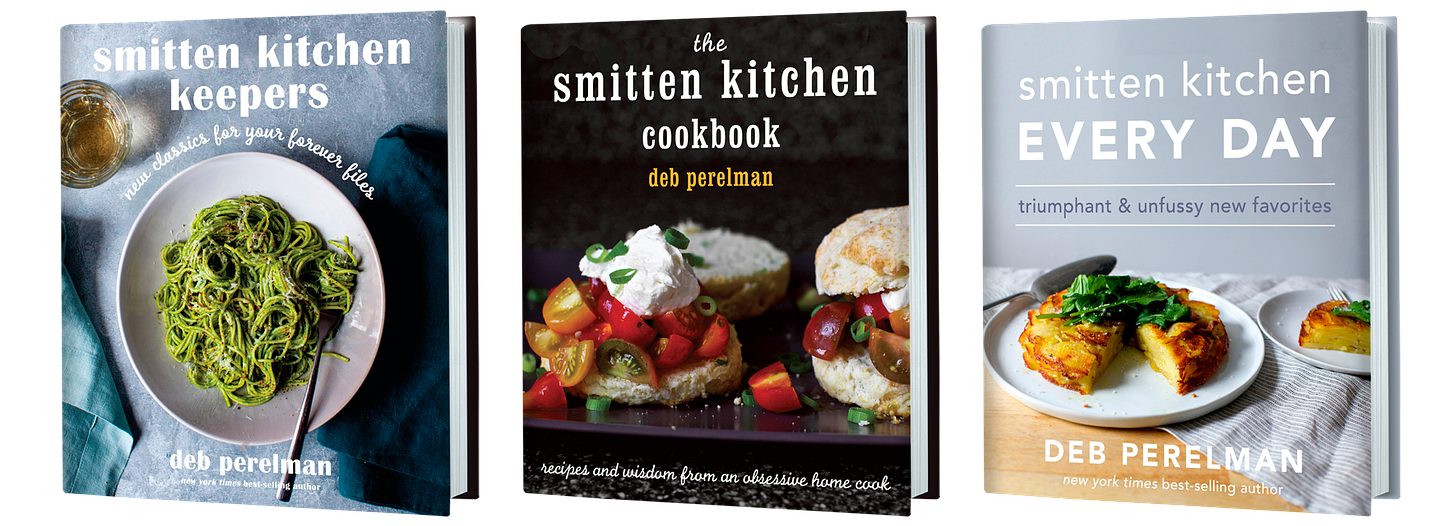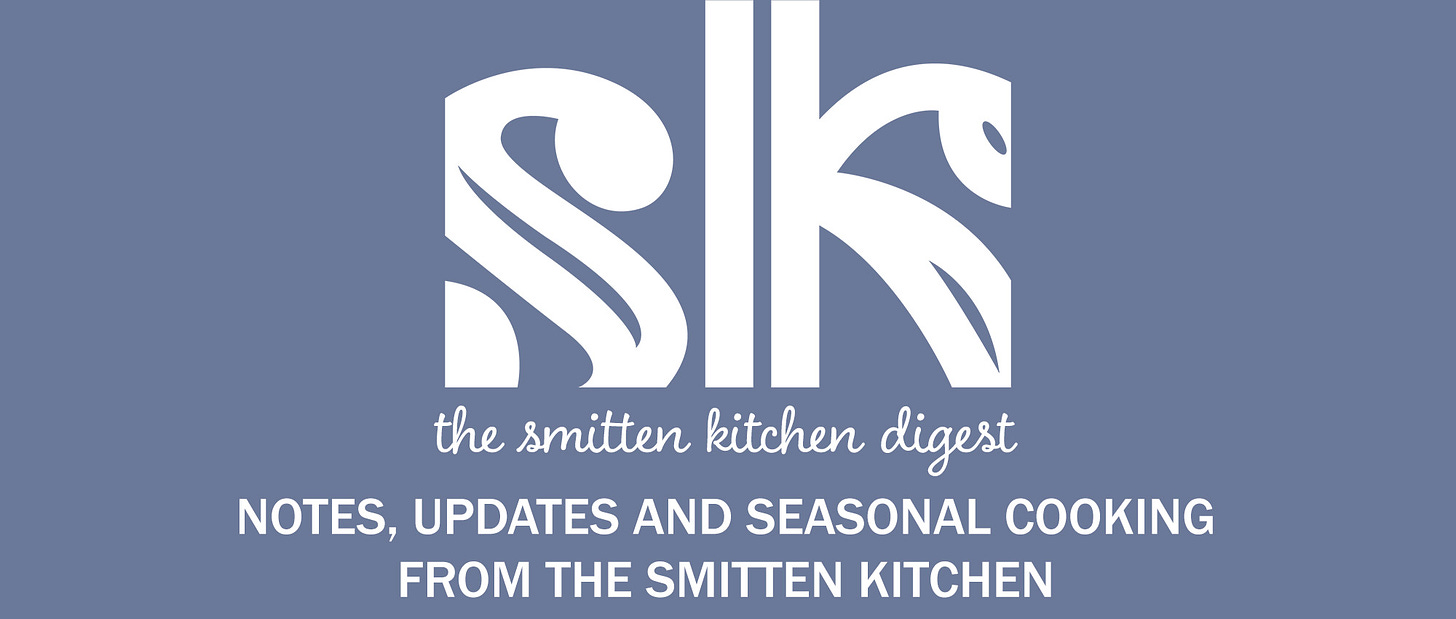spring pastas
Monday, April 21, 2025
Good afternoon!
Why is dining alone so difficult? [NYTimes, unlocked]
We just returned from a week in Amsterdam for my kids’ spring break and it was honestly perfect — the tulips were at peak, the weather was mild, there appeared to be a french fry truck or shop on every corner (bliss), and when the kids got tired we sent them back to the hotel to veg and ducked into a brown bar. Probably like everyone who has ever visited Holland, I immediately came home and vowed to replace my rusted-out bike with a proper omafiet with a milk crate (so practical!) bolted to the front. I’ll write up the trip soon and share the page here when it’s ready.
Back in NYC, spring was in full swing on my walk this morning with a shower of pink and white petals over some sidewalks and a sea of daffodils in every park. I’m dragging this energy right back to the kitchen with me this week with a collection of spring pastas that feel as fresh as the season. I hope you find a new favorite.
Cheers,
Deb
I’ve written three cookbooks and I’m a tiny bit biased, but I think you’d love them all. Wondering what you might cook from Smitten Kitchen Keepers now that flowers are budding and the air is warming? I thought you’d never ask! Try the pea, feta, and mint fritters, toasted ricotta gnocchi with pistachio pesto, baked orzo and artichokes, and fettuccine with white ragù. To finish, I recommend the bee sting bars and the carrot cake with brown butter and no clutter. Were you looking for a list of all the recipes in each of my cookbooks? I’ve added these in a separate page and hope it makes it easier for you to find everything you want to cook.
“One of the winning elements of ‘The Recipe’ is that it’s not prescriptive — rather than settling on one universal ‘perfect’ recipe, the chefs explain their personal preferences, then give listeners the information they need to make their own adjustments. By breaking their recipes down ingredient-by-ingredient, digging into what each one is doing, they make the science of cooking approachable and fun.” — New York Times, 7 Podcasts to Inspire a New Hobby
“J. Kenji Lopez-Alt and Deb Perelman’s new podcast gets to not only the heart of how they make their recipes—but also the why behind each decision, too.” — Esquire, The 26 Best Podcasts of 2024
The latest full episode of my podcast with J. Kenji Lopez-Alt, The Recipe with Kenji and Deb, is all about French Toast! You can listen to it anywhere you get your podcasts, such as Apple, Spotify, and more.
bowties with sugar snaps, lemon and ricotta
This pasta is always a massive hit for something so seemingly simple. Ricotta is dolloped in near the end but not stirred or cooked (because we love finding the unmixed pockets later) and then the whole dish gets a six-part finish: olive oil, lemon juice, salt, pepper, parmesan and slivers of mint. No sugar snaps yet? Use anything green you like, lightly cooked.
asparagus, goat cheese and lemon pasta
Turns out, goat cheese makes a shockingly simple but effective creamy pasta sauce with asparagus and lemon, and since it takes only 20 minutes to make, you'll have more time leftover to do anything else.
fresh spinach pasta
Weekend cooking project? Homemade, handmade, old-school fresh pasta with deep green specks of real spinach is doable and delicious. Serve with absolutely nothing save a drizzle of olive oil and parmesan; this is total centerpiece material.
pasta and white beans with garlic-rosemary oil
This pasta is hearty, getting its awesomeness not from the usual crutches of dairy, cheese, or fatty meats, but a finish of sizzling garlic-rosemary oil and crunchy sea salt. Wednesday, now I'm ready for you.
broken pasta with pork ragu
Looking for a special but not too daunting weekend dinner? I credit the bright salad-y finish of parmesan, lemon, and sharp arugula with making this ragu feel spring-like but still cozy.
linguine with pea pesto
This is the dish that converted me to shelled peas, some blended with parmesan, garlic and pine nuts, some left whole, all tangled with linguine for an especially pretty weeknight meal.
pasta with garlicky broccoli rabe
For those of us who never have any idea what's for dinner until it's hangry o'clock, this is our in-house 15-minute 4-ingredient dinner savior. It includes a pound of greens and is willingly consumed by at least 75% of the family, i.e. it’s a miracle.
green angel hair with garlic butter
The greenest thing I know how to make is also the most delicious. It's the cover star of Smitten Kitchen Keepers, my latest cookbook, a celebration of roasted garlic butter and fresh greens, tangled with pasta and it's the kind of recipe we made once then again and again -- an instant classic. Have you gotten hooked on it yet?
carrot cake with coconut and dates
This flourless, dairy-optional carrot cake is hearty, spiced, perfect for the April holidays or really any day of the year, whether brunch or dessert or just because it’s Thursday and the vanilla bean-flecked cream cheese squiggles are calling to you. [Video below!]
carrot cake with coconut and dates
shop my favorites
Ever wonder where I get my cutting boards, paring knives, offset spatulas and more than you see when I cook? I've created a page on Smitten Kitchen with links to some of my favorite kitchen items, the ones I'm asked about the most — yes, including the the Smitten Kitchen x Staub Braiser (which is back in stock!). For each item, I've attempted to provide a range of shopping links so we're not just focusing on one giant retailer.
See you next week!
Dracula Daily starts in two weeks!
Hello! Matt here. A quick reminder: you’re getting this email because you signed up for Dracula Daily, the email newsletter that sends you the full text of Dracula in real time. If that doesn’t sound familiar, you can unsubscribe at the link at the bottom of this email.
I’m writing this pre-season email to let you know about something new I’m going to try in 2025: Dracula Weekly.
But first: it’s the two week countdown!
The story of Dracula starts on May 3, which means we’re just two weeks away. Dracula is fun to read along with people, so if there’s anybody in your life you’d like to join this book club with, get ‘em on board now! :)
On May 3 you’ll get the first section of the book, as we meet Jonathan Harker. After that, you’ll only get emails on days when there’s action in the book.
Confused about how this works? I cover some common questions here. https://draculadaily.substack.com/about
OK, what was that about Dracula… Weekly?
This email platform has a feature that lets people pledge monetary support for a newsletter. It’s not something I set up, and Dracula Daily has always been free. And to be clear - it will continue to be free! It’s too much fun to restrict to only people who pay money!
But some of you readers have found a way to set up a pledge, meaning that I can turn on ‘paid’ subscriptions. Many of you have written incredibly nice and encouraging messages of support with those pledges. Really, they’re so great - I literally go back and re-read your messages when I feel sad.
But the idea of creating a ‘paid’ tier always felt weird without giving you something extra in return. This operation does take a lot of work, but I absolutely do it for fun. I didn’t want to take pledges unless there was some extra value for you! So this year I’m going to try it out, with Dracula Weekly.
Here’s what I’m thinking:
Paid subscribers get access to Dracula Weekly, a new weekly email. Here’s what I’m envisioning for that:
- A recap. I’ll write a summary of what happened this week in the daily emails. This could be useful if you fall behind in the daily reading, especially in the fall when you can start getting a LOT of text at once.
- A roundup. The community responses to Dracula Daily emails are so incredible. But if you’re not very online you might not see these, or even know where to look. Or you might be terminally online, but still not be hanging out on every social platform at once. So: I’ll include a roundup of links to some great responses that people make - highlights from the artists and writers that create memes, jokes, artwork, essays, and more. Hopefully you’ll find a bunch of new cool people to follow!
- And more? What else sounds fun to have in a Dracula Weekly email? I’d love your thoughts. Probably also some other Dracula or classic lit or gothic-adjacent stuff to recommend?
- A vote of support. Probably the biggest thing you’d get - and this is I think the only reason why anybody has pledged so far - is just to support the project.
- Oh and some merch to say thank you. For the first ~hundred or so people that claim it at least! I made enamel pins to celebrate the launch of the hardcover edition of Dracula Daily, and I’ve still got some of those, plus I have a few of the motel-style keychains from Castle Dracula. I’d love to send those to you as a freebie, just a way to say thanks. Note that there’s only a limited quantity of those, so it will need to be first come first serve, I guess. I’ll put a link to claim them in the first Dracula Weekly emails.
SO: What does this mean for you?
- If you’ve pledged - we’ll start actually accepting your pledge, and you’ll get the new Dracula Weekly emails. If you made that pledge in substack and you don’t actually want to proceed, that’s fine! Cancel that now! No problem. blood, no foul.
- If you never pledged anything and this doesn’t sound interesting, No worries! The regular Dracula Daily emails will go out as usual, and you’ll get the full book and the full experience. You don’t need to do anything.
- If you haven’t pledged and you WANT to join in and support Dracula Daily, here’s a link (at least I think this is how it works):
But really - NO pressure here, you don’t need to subscribe to read Dracula with us!
OK! That’s it - thanks for reading along. Doing this Dracula thing is only possible and certainly only fun because of you, dear reader.
And get ready for the book to start - we meet our good friend Jonathan on May 3!
Anglo-Saxon
The first thing that made me want to write about Anglo-Saxon was my experience of French exchange students using the term to mean 'anglophone, English-speaking'. I'd warn them against the term, stating (but perhaps not explaining) that it is inaccurate and has connotations they didn't intend in British/American English. (So here comes the explanation.) The second thing is that I've been writing about the history of English and have chosen to mostly refer to Anglo-Saxon rather than Old English and I'm thinking about that choice. The third thing is that Dave Wilton (who writes the fantastic Word Origins newsletter) published a paper in 2020 on the topic that's been on my TBR pile for a while—so writing this post provided me with an excuse to take the time for it.
Anglo-Saxon v Old English
 |
- ca. 450AD/CE to 1150ish: Old English/Anglo-Saxon.
from the Germanic invasions till the start of Middle English. This can be further divided into prehistoric (450–650), early (650–900) and late periods (900–1150). Beowulf is the most famous literary work from this time. - 1066 to 1500ish: Middle English
from the Norman (French) invasion through the Great English Vowel Shift. This also has early and late periods. Chaucer's Canterbury Tales is the most famous bit. - 1500ish to 1650ish: Early Modern English
Shakespeare times. King James Bible times. - 1650ish to now: Late Modern English
No more thou, no more hath, and lots more vocabulary thanks to industriali{s/z}ation and the spread of English worldwide.
Anglo-Saxons = English speakers?
At the height of the British Empire, English intellectuals were taken with the notion of an “Anglo-Saxon race”, tracing its roots to the Germanic peoples who settled in Britain after the Romans left in the 5th century. With self-satisfaction they concluded that their “race” was something special, illustrated by the strength of their culture over that of the conquered Celts, their early codification of individual rights with the Magna Carta in 1215, and their break with the Roman church in the 16th century. Belief in their own good example made appropriating other peoples’ lands much easier to justify – and Americans of English stock were happy to share in this myth. But by the 20th century, talk of an Anglo-Saxon race had fallen out of fashion, and instead of genetic inheritance, it was language that seemed to unite us.
Thus we started to be called the English-speaking peoples, a term used with particular influence by two statesmen-historians, Theodore Roosevelt in The Winning of the West and Winston Churchill in A History of the English-speaking Peoples. President and prime minister turned to this language-based description of “our peoples” because other possible descriptions had become impossible.
My French students were still using the Anglo-Saxon race to refer to 'the English-speaking peoples'. One problem in using the term that way is that "races" allegedly have a common genetic heritage, and English-speakers don't. Many Americans cannot trace their ancestry back to England. We are a transatlantic linguistic group and we share some aspects of our cultures. But it's weird to call us a race in contemporary English.
- une politique audacieuse pour défendre la langue et la culture française qui se trouvent aujourd'hui particulièrement menacées par l'invasion de la langue anglaise et de la culture anglo-saxonne .
a bold policy to defend the French language and culture, which are today particularly threatened by the invasion of the English language and Anglo-Saxon culture.
- L'hôpital a mis en place un concept qui vient des pays anglo-saxons nommé "Kids friendly".
The hospital has implemented a concept that comes from Anglo-Saxon countries called "Kids friendly".
- cette brutale franchise, qui caractérisent la race anglo-saxonne .
that brutal frankness, which characterizes the Anglo-Saxon race. - Cette ardeur chrétienne est-elle particulière à la race anglo-saxonne ?
Is this Christian ardo(u)r peculiar to the Anglo-Saxon race?
The Anglo-Saxon race-ism
- "The new Constitution eliminates the ignorant Negro vote and places the control of our government where God Almighty intended it should be – with the Anglo-Saxon race ," John Knox, the president of the [Alabama] constitutional convention, said in a speech encouraging voters to ratify the document [in 1901] [source]
- Galton declared that the "Bohemian" element in the Anglo-Saxon race is destined to perish, and "the sooner it goes, the happier for mankind." [source]
WASP
For the sake of brevity we will use the nickname 'Wasp' for this group, from the initial letters of ‘White Anglo-Saxon Protestants’.
Three uses of Anglo-Saxon in American and British corpora (Wilton 2020)
Wilton, David. 2020. What Do We Mean By Anglo-Saxon? Pre-Conquest to the Present. The Journal of English and Germanic Philology 119.425–454. doi:10.5406/jenglgermphil.119.4.0425.
Wilton tracks three uses of Anglo-Saxon:
- Pre-Conquest: referring to the Germanic peoples of Britain before 1066
- Politicocultural: "references to the politics, economics, and culture of present-day Britain, the United States, Canada, Australia, and New Zealand, and especially the transnational characteristics that these nations share that are not explicitly ethnic or physiognomic." (p. 433) So: like the French usage above.
- Ethnoracial: "any use of Anglo-Saxon that is applied to an individual person; that refers to physiognomy, personal appearance, DNA or genetics or ancestry; or that contrasts Anglo-Saxon with another ethnic or racial group, as well as instances of the phrase white Anglo-Saxon Protestant and the acronym WASP." (p. 433)
Moving on to more recent times, here's what Wilton found in the Corpus of Contemporary American English (COCA):
In Britain, there's either even (BNC, 1980–93) distribution of ethnoracial and politicocultural or lots more politicocultural (NOW, 2010s). Wilton writes:
One might have expected an increase in the ethnoracial uses of “Anglo-Saxon” [in the UK] since the advent of the Brexit era, but the data shows this not to be the case. Any impression otherwise is probably due to increased awareness of ethnoracial uses of the term. In other words, people are only now noticing the uses that have always been there or are now reading ethnic connotations into the term that they had not before.
A wise American reporter based in London once told me that every British news story is, deep down, about class. Every American story, he said, is about race.
Whale Weekly: April 19
Summary
Annotations
Audiobook (8:53:27-9:00:20)
CHAPTER 46. Surmises.
Though, consumed with the hot fire of his purpose, Ahab in all his thoughts and actions ever had in view the ultimate capture of Moby Dick; though he seemed ready to sacrifice all mortal interests to that one passion; nevertheless it may have been that he was by nature and long habituation far too wedded to a fiery whaleman’s ways, altogether to abandon the collateral prosecution of the voyage. Or at least if this were otherwise, there were not wanting other motives much more influential with him. It would be refining too much, perhaps, even considering his monomania, to hint that his vindictiveness towards the White Whale might have possibly extended itself in some degree to all sperm whales, and that the more monsters he slew by so much the more he multiplied the chances that each subsequently encountered whale would prove to be the hated one he hunted. But if such an hypothesis be indeed exceptionable, there were still additional considerations which, though not so strictly according with the wildness of his ruling passion, yet were by no means incapable of swaying him.
To accomplish his object Ahab must use tools; and of all tools used in the shadow of the moon, men are most apt to get out of order. He knew, for example, that however magnetic his ascendency in some respects was over Starbuck, yet that ascendency did not cover the complete spiritual man any more than mere corporeal superiority involves intellectual mastership; for to the purely spiritual, the intellectual but stand in a sort of corporeal relation. Starbuck’s body and Starbuck’s coerced will were Ahab’s, so long as Ahab kept his magnet at Starbuck’s brain; still he knew that for all this the chief mate, in his soul, abhorred his captain’s quest, and could he, would joyfully disintegrate himself from it, or even frustrate it. It might be that a long interval would elapse ere the White Whale was seen. During that long interval Starbuck would ever be apt to fall into open relapses of rebellion against his captain’s leadership, unless some ordinary, prudential, circumstantial influences were brought to bear upon him. Not only that, but the subtle insanity of Ahab respecting Moby Dick was noways more significantly manifested than in his superlative sense and shrewdness in foreseeing that, for the present, the hunt should in some way be stripped of that strange imaginative impiousness which naturally invested it; that the full terror of the voyage must be kept withdrawn into the obscure background (for few men’s courage is proof against protracted meditation unrelieved by action); that when they stood their long night watches, his officers and men must have some nearer things to think of than Moby Dick. For however eagerly and impetuously the savage crew had hailed the announcement of his quest; yet all sailors of all sorts are more or less capricious and unreliable—they live in the varying outer weather, and they inhale its fickleness—and when retained for any object remote and blank in the pursuit, however promissory of life and passion in the end, it is above all things requisite that temporary interests and employments should intervene and hold them healthily suspended for the final dash.
Nor was Ahab unmindful of another thing. In times of strong emotion mankind disdain all base considerations; but such times are evanescent. The permanent constitutional condition of the manufactured man, thought Ahab, is sordidness. Granting that the White Whale fully incites the hearts of this my savage crew, and playing round their savageness even breeds a certain generous knight-errantism in them, still, while for the love of it they give chase to Moby Dick, they must also have food for their more common, daily appetites. For even the high lifted and chivalric Crusaders of old times were not content to traverse two thousand miles of land to fight for their holy sepulchre, without committing burglaries, picking pockets, and gaining other pious perquisites by the way. Had they been strictly held to their one final and romantic object—that final and romantic object, too many would have turned from in disgust. I will not strip these men, thought Ahab, of all hopes of cash—aye, cash. They may scorn cash now; but let some months go by, and no perspective promise of it to them, and then this same quiescent cash all at once mutinying in them, this same cash would soon cashier Ahab.
Nor was there wanting still another precautionary motive more related to Ahab personally. Having impulsively, it is probable, and perhaps somewhat prematurely revealed the prime but private purpose of the Pequod’s voyage, Ahab was now entirely conscious that, in so doing, he had indirectly laid himself open to the unanswerable charge of usurpation; and with perfect impunity, both moral and legal, his crew if so disposed, and to that end competent, could refuse all further obedience to him, and even violently wrest from him the command. From even the barely hinted imputation of usurpation, and the possible consequences of such a suppressed impression gaining ground, Ahab must of course have been most anxious to protect himself. That protection could only consist in his own predominating brain and heart and hand, backed by a heedful, closely calculating attention to every minute atmospheric influence which it was possible for his crew to be subjected to.
For all these reasons then, and others perhaps too analytic to be verbally developed here, Ahab plainly saw that he must still in a good degree continue true to the natural, nominal purpose of the Pequod’s voyage; observe all customary usages; and not only that, but force himself to evince all his well known passionate interest in the general pursuit of his profession.
Be all this as it may, his voice was now often heard hailing the three mast-heads and admonishing them to keep a bright look-out, and not omit reporting even a porpoise. This vigilance was not long without reward.
Decipherment of the Indus script: new angles and approaches, part 4
These are remarks by Ron Vara from here:
ᱮᱞᱚᱱ ᱨᱤᱣ ᱢᱩᱥᱠ ( /ˈiːlɒn/ EE-lon; ᱡᱟᱱᱟᱢ ᱡᱩᱱ ᱒᱘, ᱑᱙᱗᱑) ᱩᱱᱤ ᱫᱚ ᱢᱤᱫ ᱵᱮᱯᱟᱨᱤᱭᱟᱹ ᱠᱟᱱᱟᱭ ᱚᱠᱚᱭ ᱫᱚ ᱩᱱᱤᱭᱟᱜ ᱢᱩᱲᱩᱫ ᱵᱷᱩᱢᱤᱠᱟ Tesla, Inc., SpaceX, ᱟᱨ ᱴᱩᱭᱴᱚᱨ (ᱡᱟᱦᱟᱸ ᱩᱱᱤ ᱮᱠᱥ ᱞᱮᱠᱟᱛᱮ ᱧᱩᱛᱩᱢ ᱵᱚᱫᱚᱞ ᱮᱱᱟ) ᱨᱮ ᱵᱟᱰᱟᱭᱚᱜ ᱠᱟᱱᱟ᱾
This is the first sentence in the article Elon Musk in Santali alphabet (Ol Chiki). Yes, it's an alphabetic writing system, not an abugida. What makes the Santali alphabet really elusive is that it resembles the shapes of the undeciphered Indus Valley script. Soviet archaeologists once tried to decipher IVC seals using Santali alphabet. Sounds ridiculous, but it's a sad truth that Santali is a unique language with little to no academic attention having been paid to it.
What makes Santali language itself stand out is the lack of "indianization" as compared to even Southeast Asian Austroasiatic languages like Mon and Khmer. Its phonology is still archetypically East Asian with a superimposed South Asian areal layer. Its morphology is somewhat mixed between SEA Austroasiatic prefixing and (self-innovative) highly polysynthetic verb akin to the Kiranti languages (spoken ~20 kilometres away in Nepal), so Santali is not remotely influenced by Sanskrit, except for a few Austroasiatic loanwords in early Vedic Sanskrit.
Selected readings
- "Decipherment of the Indus script: new angles and approaches, part 3" (3/28/25)
- "Decipherment of the Indus script: new angles and approaches" (3/6/25) — with useful bibliography
- "Decipherment of the Indus script: new angles and approaches, part 2" (3/22/25)
Are all writing systems equally easy / hard?
Some folks seem to think so, but not Benjamin James who wrote this letter to the London Review of Books, 47.6 (April 3, 2025), p. 4:
Simple Script
In his fascinating article on the recent decipherment of Linear Elamite, Tom Stevenson finds it difficult to accept that 'the Latin or Greek writing systems are simpler or "more precise" than mostly logographic writing systems like written Chinese' (LRB, 6 March). Does he really believe Chinese script is just as suited as Latin to the rendering of foreign words? 'Tom Stevenson' is far simpler and more phonetically precise than 汤姆•史帝⽂森,'Tangmu Shidiwénsen', which adds two syllables, six tones and six individual character meanings. The Committee for Language Reform in China acknowledged the relative simplicity of the Latin script as one of the factors behind its abandonment in 1956 of the attempt to develop a phonetic script based on Chinese characters.
If Stevenson says this because he thinks the idea of one script being simpler than another is somehow discriminatory (as well as untrue), then he might prefer to consider the example of the long-vanished Tangut people, who possessed, according to the Tangutologist Gerard Clauson,
one of the most inconvenient of all scripts, a collection of nearly 5800 characters of the
same kind as Chinese characters but rather more complicated . . . It is extremely difficult to remember them, since there are few recognisable indications of sound and meaning in the constituent parts of a character, and in some cases characters which differ from one another only in minor details of shape or by one or two strokes have completely different sounds and meanings, Imagination boggles at the thought of teaching typesetters to set it up.
The Tangut script, supposedly created by a single Chinese bureaucrat in 1038, died out at the start of the 16th century – to the probable relief of future generations, who were free to write in Chinese, Tibetan, Mongolian or some other comparatively simple script.
Here I would like to pay tribute to two Tangutologists:
Sir Gerard Leslie Makins Clauson (1894-1974) — larger than life, he was "an English civil servant, businessman, and Orientalist best known for his studies of the Turkic languages. He was born in Malta." Here I am celebrating his achievements in Tangut studies, but his accomplishments in Turkology were. to me, supernatural. When I behold his An Etymological Dictionary of Pre-Thirteenth-Century Turkish (Oxford: Clarendon Press [1972]), which was almost like a bible for me when I was studying Old Turkish and Tocharian (!!), I think that alone would be enough for any scholar to produce in one lifetime, but there is much more:
…
Clauson attended Eton College, where he was Captain of School, and where, at age 15 or 16, he published a critical edition of a short Pali text, "A New Kammavācā" in the Journal of the Pali Text Society. In 1906, when his father was named Chief Secretary for Cyprus, he taught himself Turkish to complement his school Greek. He studied at Corpus Christi College, Oxford, in classics, receiving his degree in Greats, then became Boden Scholar in Sanskrit, 1911; Hall-Houghtman Syriac Prizeman, 1913; and James Mew Arabic Scholar, 1920. During World War I, he fought in the battle of Gallipoli but spent the majority of his effort in signals intelligence, concerned with German and Ottoman army codes.
These were the years in which the great Central Asian expeditions of Sven Hedin, Sir Aurel Stein and others were unearthing new texts in a variety of languages including Tocharian and Saka (both Khotanese, and Tumshuqese). Clauson actively engaged in unraveling their philologies, as well as Chinese Buddhist texts in the Tibetan script.
Clauson also worked on the Tangut language, and in 1938–1939 wrote a Skeleton dictionary of the Hsi-hsia language. The manuscript copy is held at the School of Oriental and African Studies in London, and was published as a facsimile edition in 2016.
In 1919 he began work in the British Civil Service, which was to culminate in serving as the Assistant Under-Secretary of State in the Colonial Office, 1940–1951, in which capacity he chaired the International Wheat Conference, 1947, and International Rubber Conference, 1951. After his mandatory retirement at age 60, he switched to a business career and in time served as chairman of Pirelli, 1960–1969.
A partially filled notebook containing Sir Gerard Clauson's Notes on Kashgari's Divan lugat at-Turk [VHM: the first comprehensive dictionary of Turkic languages] and other cognate subjects (1072-74) is held at the Cadbury Research Library, University of Birmingham.
If we're talking about someone who knew difficult languages and mind-numbing scripts, it was Clauson. He authoritatively knew whereof he spoke.
Nikita Kuzmin
He completed his PhD at the University of Pennsylvania in 2023 on the following subject:
"Pilgrimage in Tangut Xia: Study of Tangut Epigraphy from Dunhuang and Tangut Woodblock Prints from Bezeklik". (free PDF)
Abstract
This dissertation aims to examine the pilgrimage activities of the Tanguts in the 11th–13th centuries in the Hexi Corridor, based on the research of the two corpora of Tangut received textual materials – Buddhist inscriptions that pilgrims left on the walls of the Buddhist cave complexes of Mogao and Yulin and the fragments of Tangut Buddhist texts excavated from Bezeklik. Chapter 1 introduces various manifestations of pilgrimage and articulates features of Buddhist pilgrimage in multiple regions in Asia. Chapter 2 displays the historical and religious characteristics of Mount Wutai and the greater Dunhuang area, which played a crucial role in the establishment and development of Tangut Buddhism. It also discusses various external factors (Uyghur monks) that influenced the propagation of Buddhism among the Tanguts. In Chapter 3, I analyze the remained Tangut inscriptions from Mogao and Yulin caves and interpret them within corresponding historical and religious contexts. Based on the comparative research of the inscriptions, I argue the existence of a unified “inscriptional discourse” in the greater Dunhuang area in the 10th to 13th centuries. Chapter 4 discusses codicological and contextual features of a corpus of Tangut Buddhist woodblock prints from Bezeklik caves. In the end, the dissertation provides an English translation of 22 inscriptions and 12 pieces of Tangut woodblock prints.
To accomplish this arduous task, one of the first things I had Nikita do was go off to Kathmandu to study Classical Tibetan for a summer. He already knew Mandarin (virtually native fluency) and Classical Chinese, Japanese, German, and his native Russian. Oh, yes, and was fluent in English.
No, to all those doubting Thomases out there who think that mostly logographic scripts like Tangut and Chinese are as simple and precise as the Latin or Greek alphabet, they are not.
If you only have one year to learn a new script, don't try Tangut or Chinese.
Selected readings
- "Decipherment of Linear Elamite" (9/5/2022)
- "Tangut beer" (10/13/18)
- "Tangut workshop at Yale" (2/2/18)
[Thanks to Leslie Katz]
Brain Mechanisms and Constructed Languages vs. Natural Languages
"Constructed Languages Are Processed by the Same Brain Mechanisms as Natural Languages." Malik-Moraleda, Saima, et al. Proceedings of the National Academy of Sciences 122, no. 12 (March 17, 2025): e2313473122.
Significance
Abstract
Pursuing the questions raised in this paper will help us distinguish between linguistic and non-linguistic domains of intellectual inquiry — math, music, art….
Selected readings
- "The origin and progress of linguistic norms" (2/22/09)
- "Natural language and artificial intelligence" (5/29/04)
[Thanks to Ted McClure]
Crosswalk protest art
Last weekend, a number of crosswalk buttons in Silicon Valley were hacked so as to play (faked) messages from Mark Zuckerberg and Elon Musk. This got lots of (social and mass) media coverage — for one useful summary, see Zoe Morgan, "Silicon Valley crosswalk buttons apparently hacked to imitate Musk, Zuckerberg voices", Palo Alto Online 4/12/2025, or check out various other sources…
Some audio samples:
Today's AI synthesis and voice morphing technology makes it easy to create such clips — and crosswalk buttons are not the only possible medium to be hacked.
And of course there will be targets from other regions of the political and cultural space.
Update — Apparently the same sort of thing happened yesterday in Seattle: "'Please don’t tax the rich': Seattle crosswalk buttons hacked to sound like Jeff Bezos", 4/16/2025. Reddit has a sample video.



































